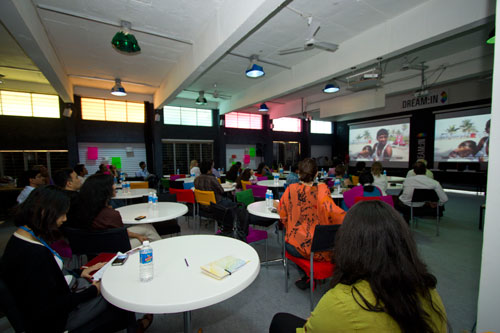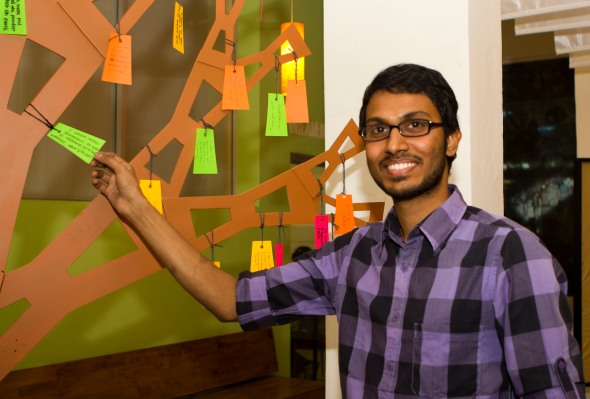Big Dreamer Insight: Kishore Biyani
Posted: February 17, 2011 Filed under: DREAM:IN Conclave | Tags: conclave, DREAM:IN, dream:in center, q&a 1 CommentBelieve in oneself – Kishore Biyani, CEO: Future Group
Responses from Kishore Biyani during Dream Session 1:
Equal Dreams — Pursuing inclusive futures
What’s your approach to retail?
I keep my eyes and ears open to observe our customers and turn those insights into How do we serve better them? When you focus on the consumers’ perspective and what can be done for them rather than just on how to move goods – that changes everything.
How do you capture and interpret customer insights?
We start by taking note of memes within popular culture with things like TV serials, cinema, songs, etc. We ask ourselves Why is this getting popular? What’s driving this? – because there’s a reason why these specific stories have captured the imagination of the people. We believe since these stories resonate widely that it’s reflective of the dreams people share.
What is the role of business in helping individuals achieve their dreams?
An organisation is a collection of many individuals, with their own dreams, coming together to work on a common vision. It then becomes our responsibility as managers and human beings to ensure that we start asking ourselves how do we increase their satisfaction and thinking capacity – it’s not just about economic output.
You’ve mention that dreaming is the essence of simplicity. Can you elaborate on that?
I’ve come to learn that design thinking has a place in business. People have a tendency to create a lot of complexity with layers and layers of thought when most issues actually have simple solutions. Unfortunately our system has conditioned us to think that you’re not a good manager unless you complicate things then solve them! On the other hand, people’s dreams are often simple and positive. This simplicity should inspire our problem solving.
What is your personal dream?
I believe that what differentiates us from animals is imagination and fear. One of my own observations on life is that 7 out of 10 thoughts an average person has is negative. So the big question becomes – How do we use reduce our fears and increase our imagination? I dream of being able to reduce the fear quotient and convert negative thoughts through imagination.
We are a nation that doesn’t believe in ourselves as much as we should. Even with our rich history and knowledge, we have yet to produce strong thought leaders out of India. If we are to prosper and grow, we need to plan future scenarios that not only look at economic indices but also take into account the measures of happiness, culture and values. This is a long-term approach to planning the future of India.
Re-imagining Sustainable Lifestyles
Posted: February 17, 2011 Filed under: DREAM:IN Conclave | Tags: conclave, DREAM:IN, dream:in center, mk Leave a commentThis morning participants from the DREAM:IN Conclave are brainstorming various aspects of future sustainable lifestyles based on insights collected from the Dream Journey. Alternating between scenarios, personas, dream categories – the small guy, the big picture – they are seeking to align personal dreams with tangible, inclusive, big-picture ideas for meeting them. Teams include student Dreamcatchers and professionals from various backgrounds and countries – a multi-disciplinary mix!
It’s been agreed that India’s key asset is its diversity and various avenues are being explored within this. Early notions have included vertical farms for dense urban centers, connected to community education initiatives. Rural sports centers have been proposed as a way of driving ambitions, values, health, women’s empowerment and community resilience. Many more ideas are surfacing which will be refined in this afternoon’s session with more rigor and focus.

Energy is pumping across the teams – driving intense discussions and transformative thinking.
Big Dreamer: Ramesh Vangal
Posted: February 17, 2011 Filed under: DREAM:IN Conclave | Tags: conclave, DREAM:IN, mk, quotes Leave a commentMake big changes to big things – Ramesh Vangal
Ramesh is Chairman of the Katra Group which has built a strategic presence across diverse sectors including wellness, technology and infrastructure. He led PepsiCo’s entry into India, which became the basis of a Harvard Business School case study.
Our Dream Catalyst Asks…
Posted: February 17, 2011 Filed under: DREAM:IN Conclave | Tags: conclave, dream:in center, mk, press 3 Comments
Our DREAM:IN Conclave Dream Catalyst, Bruce Nussbuam, asks on Fast Company – “can we find a new model for sustainable economic growth that doesn’t just provide for needs, but makes dreams come true?”
Dreaming Together
Posted: February 16, 2011 Filed under: DREAM:IN Conclave | Tags: conclave, DREAM:IN, mk Leave a comment
A big part of DREAM:IN is inclusivity. Here’s Future Group’s retail heavyweight, Kishore Biyani, with Amar – who was discovered during the Dream Journey. Check out Amar’s compelling dream. Together India can dream big!
Conclave Recap: Press Conference
Posted: February 16, 2011 Filed under: DREAM:IN Conclave | Tags: conclave, DREAM:IN, dream:in center Leave a comment
The DREAM:IN Conclave that will take place this week from February 16 – 19 was formally introduced yesterday by founders Sonia Manchanda and Carlos Teixeira at the Dream Center, Bangalore. Bruce Nussbaum and Kishore Biyani joined them at the panel.
Hosted by Idiom, the project is spearheaded by Spread, Idiom’s own design education initiative, and a global network of design thinkers united by a focus on innovation and inclusive growth. DREAM:IN aims to equalise the futures of individuals by tapping into their dreams and potential – creating a massive open network for a progressive and sustainable growth path.
The genesis of the project was sparked by Sonia Manchanda, co-founder and director of Idiom and Spread, who dared to ask: “Why should needs, ambitions, mere economic growth alone be the basis and measures of development? How can individuals not be victims of social, political, economic or religious systems? Systems we ourselves have helped create! Could we possibly devise a framework for equal futures, a world without divides? So, what would these dreams be, how would they be captured?”
This week the DREAM:IN core team welcomes local and global guests to participate in understanding and interpreting thousands of dreams collected earlier in January during the Dream Journey. Dreamcatchers made up of students from design, communication and film institutes had traveled across India to interview and capture individuals’ stories which will take center stage over the next four days.
“[DREAM:IN] will offer a first of its kind transformative experience to the audience who will absorb the dreams of the common Indian and our leaders, to channel dreams into big, inclusive ideas that will in turn translate into workable projects – leading to setting up networks to realise future scenarios,” stated Sonia on the goals of the project.
Carlos Teixeira, Director: Networks of DREAM:IN and Director of Academic Affairs, School of Design Strategies, Parsons The New School of Design emphasized on the value of the conclave: “DREAM:IN is reverse globalisation – bringing global talent to local opportunities. This conglomeration of young talent (Dreamcatchers), seasoned global and Indian design thinkers (Dreamcatalysts), CEOs, thinkers, leaders, policymakers (Dreamvestors), designers and managers (Dreamleaders) presents a cauldron of experience that is poised to transform the fabric of design research, management and production not only in India but also in Brazil and other centers across the world.”
As leaders and visionaries from India, Italy, Brazil, USA and Sri Lanka join the conclave – India’s own Kishore Biyani, Founder & CEO of Future Group expressed; “The Dream Index could be an interesting measure of progress. Innovation, creativity and imagination are critical to growth and development”
With the conclave about to launch, Sonia summed it up best – “Let’s dream big dreams. Let’s believe in them wholeheartedly. Then let us work towards realising a new world.”
Conclave Bytes #2
Posted: February 16, 2011 Filed under: DREAM:IN Conclave | Tags: DREAM:IN, dream:in center, dreamcatchers, mk, quotes Leave a commentAttach yourself to the effort, not the fruit of the effort – Sanskrit proverb.
If you can dream it you can do it – Ramesh Vangal
The difference between an animal and a human being – imagination.
My dream is to enhance India’s imaginings. – Kishore Biyani
By bringing 21st century technology to our village schools,
we’re only just waking up to their dreams – Bhagya Rangachar
On emerging markets: change can last forever
but the moment for change is a short window – Carlos Teixeira
We felt like we were catching the pulse of the nation –
shoe-shiners, teachers, wrestlers, refugees & more.
It ignited passion in all of us to fulfill their dreams
– Naina Jain, Dreamcatcher
If a dream is a fruit – you need to get past the outer hard part (needs & fears)
We’re after the dream seed – Sonia Manchanda
The balance of tradition and modernity
is required to design inclusively for India – Kishore Biyani
An organisation is a collection of people with dreams.
How do we build on this as managers? – Kishore Biyani
If you come with the mindset of working for your customers & their dreams,
it changes the equation of retail – Kishore Biyani
And gem from late yesterday:
If we ‘ideate’ – why don’t we ‘actionate’? – Izabel Barros, Brazil
New words being coined at DREAM:IN!
Dreamcatchers are Back!
Posted: February 16, 2011 Filed under: DREAM:IN Conclave | Tags: conclave, DREAM:IN, dreamcatchers, mk Leave a comment44 Dreamcatchers from the DREAM:IN Journey were invited back to join us for the conclave. Here’s a few of them we managed to round up. No time for rest – we’re keeping them well busy!
Q&A with Tej Valluru
Posted: February 16, 2011 Filed under: DREAM:IN Conclave | Tags: conclave, dream:in center, dreamleader, q&a Leave a commentAs leaders and visionaries from around the world gather at the Dream Center to transform dreams and ideas into workable, transformative scenarios – we profile the individuals who make it happen. Meet Dreamleader Tej Valluru, a young entrepreneur from Vijayawada A.P.
How did you get involved with DREAM:IN?
I found out about Idiom and DREAM:IN when I came across an article on Fast Company by Bruce Nussbaum. Even though my formal background is in finance and Business IT – I’ve always been interested in the fusion of business and design. I was very excited that Idiom was leading the way in India with design thinking. Although it was too late to join the Dream Journey, I am grateful to Nimesh Pilla who’s been great in helping me get onboard for the Dream Conclave.
What does design thinking mean to you? What role does it play in your life?
I believe that design is a process of thought. Creativity is not just limited to one field — creativity overall is in the process of thought. I think that the way Indians think has a lot of lacking in a few ways. Indians lean more towards religion, what has been told and what has to be followed rather than thinking further about what is right for the right time and what is good for the next thing.
For example, when it comes to defining a career path, a child will be encouraged to choose between becoming a doctor, lawyer or engineer. This myopic view results in a mass hysteria of engineers and doctors coming out of the system. We need to start thinking more broadly about the future and design thinking encourages this.
What are your hopes for the project?
Every business is framed by economics, profits and numbers. I personally believe that business has lost its human touch. I hope that the DREAM:IN project will be able to incubate businesses that are more ‘human centered’. It doesn’t mean you shouldn’t be looking at numbers but why not give your customer joy while looking at numbers?
And what’s your dream?
My personal dream is to revamp the Indian transport system since travel and cars are a passion of mine. By looking at issues of comfort, transparency, consistency and innovation in service – I want to introduce a new system that will ensure that it’s up to par on a global standard while making India a model for developing countries to emulate.
Conclave Bytes #1
Posted: February 15, 2011 Filed under: DREAM:IN Conclave | Tags: conclave, DREAM:IN, mk, quotes Leave a commentIndia needs to dream big. This is our time. – Kishore Biyani
We think there’s an idea in each of the dreams we’ve captured.
Our challenge at DREAM:IN: how to meet them? – Sonia Manchanda
How do we capture the imagination of Indians?
I can’t to do it all from Bombay. – Kishore Biyani
We’re looking at the bottom of the pyramid as well as the top & from the side.
All perspectives are important – Sonia Manchanda
Harnessing dreams over needs as a driver for economic growth
is a total breakthrough by DREAM:IN. – Bruce Nussbaum
Challenges from emerging markets should be seen as opportunities.
We need commitment & capacity. – Carlos Teixeira
What can tomorrow look like? We’re looking at dreams of common people,
the rich, the smart, the imaginative. – Sonia Manchanda















